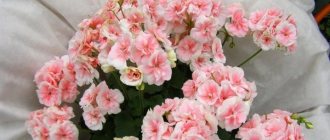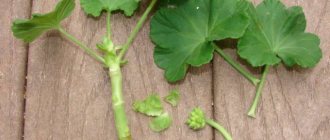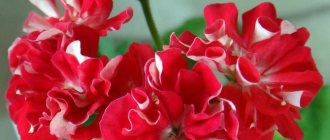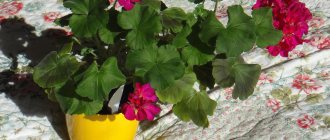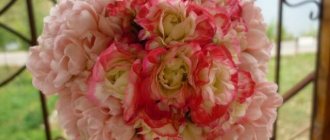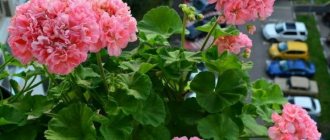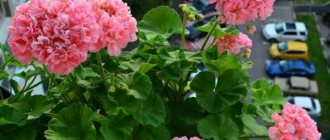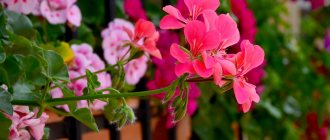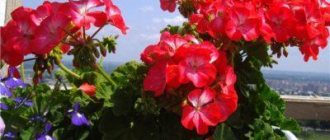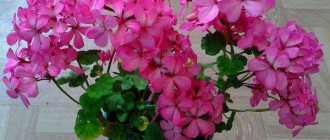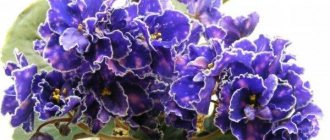Among the variety of indoor plants, flowering varieties are especially popular among gardeners. A place of honor in this list is occupied by pelargoniums, which are better known to ordinary people under the name “geranium”. Breeders have developed many varieties with very different colors and shapes of inflorescences. Thanks to the work of German scientists, a whole group of Salmon varieties has appeared, all of whose representatives are so decorative that they definitely deserve attention.
Pelargonium belongs to the Geraniaceae family. The birthplace of the flower is South Africa. The name of the plant comes from the word pelargos, which means crane in Greek. And indeed, after the end of flowering, the overgrown column of the pistil resembles the beak of a crane. Externally, all varieties are similar and have some common characteristics.
Appearance and characteristics of pelargoniums
Description
An adult pelargonium plant is a herbaceous perennial with beautiful pubescent leaves and simple or double flowers collected in inflorescences.
The leaves differ in shape and color depending on the variety. The leaf color of most varieties is dark or light green. Some new varieties, for example representatives of the Salmon group, have a darker leaf color with pronounced veins. Sometimes there is a brown or burgundy edging along the ribbed edge.
Flowers can be single or double. In all varieties they are collected in umbrella inflorescences. The color of the petals can be very diverse - from snow-white to dark burgundy.
For reference! In some varieties of pelargonium, the color may have two colors at once, usually one color is in the middle of the flower, and the second is present on the rest of the petals.
Features of cultivation
A sunny place is given for pelargonium.
When growing at home, the pot is placed on the south or southeast side. If this is not possible, additional lighting will be provided. In bright sun, bushes are slightly shaded to avoid burns. The crop is planted in loose fertile soil. Approximate composition:
- leaf soil;
- coarse sand;
- charcoal;
- peat.
The optimal proportion is 3:1:1:1. The layout in the garden is 35x35 cm.
Additional Information. You can buy ready-made soil mixture for geraniums in a specialized store.
Boarding time:
- at home - February-November;
- to the balcony or flower garden - after stable warm weather has established.
Caring for the crop consists of:
- watering;
- feeding;
- pruning
Important! Pelargonium is watered regularly. The soil should always be moist, but stagnation of water should not be allowed
In hot weather, spraying is carried out.
Feeding is carried out twice:
- at the beginning of the season - nitrogen-containing fertilizers for the development of green mass;
- before flowering - potassium and phosphorus so that more flowers are formed.
Pelargonium grows quickly, so pruning is carried out periodically. If this is not done, flowering will be sparse and short-lived. To make the bush grow wider and not higher, pinch the top.
Growing
The optimal temperature for development is +17…+23°C. In winter, the plant enters a dormant phase to gain strength for flowering next season. When growing it outside, it is better to dig it up and bring it home so that it does not freeze. In regions with warm climates, it is permissible to leave it in the open ground under cover.
In winter, the temperature at home is reduced to +13...+15°C. At this time, the plant is not fed or watered. In the spring it will wake up and begin to bloom again.
Pelargonium Pak is propagated by cuttings, like other flowers. With the seed method, varietal qualities are not inherited.
Important! If the growing rules are not followed, the flower is affected by diseases - various types of rot: root, stem, gray. Fungicides are used for control
The plant is also systematically inspected for the presence of pests.
Landing rules
It is advisable to plant this beauty in mid-April or early May, when the soil is already well warmed up. Before planting, it is advisable to rub large Salmon pelargonium seeds a little with fine sandpaper.
High-quality planting material can be purchased in specialized stores.
- To plant, you need to fill a wooden box with nutritious soil.
- Then make grooves at a distance of 2-3 cm.
- Place the seeds every 1.5 cm, lowering them to a depth of 1 cm. The plantings do not have to be sprinkled with soil; it is enough to cover them with film.
- Sprouts will appear in 14-20 days. After they have formed 2 leaves, they can be transplanted into containers with a diameter of no more than 10 cm.
- Pour the soil to the edges of the pot, and make a depression in the center.
Pelargonium is a light-loving plant, so choose sunny places for planting.
The flower tolerates heat, drought and cold well. It is advisable to feed with fertilizers with a low nitrogen content. The plant does not need careful care, but hypothermia, lack of light and moisture can provoke bacterial wilt.
Make sure there is no stagnation of water and waterlogging of the soil. Remove dried flowers promptly.
Lighting
Homemade Salmon geraniums should be placed on south, south-east and south-west windows. Flowers must be protected from the scorching sun with light curtains.
In winter, if you want to extend the flowering period, you need to provide the plant with lighting. Well-lit places and partial shade are suitable for outdoor bushes.
The soil
"Salmon" prefers loose, breathable soil with low acidity and moderate nutrition.
The substrate must include:
Plants need good drainage so that moisture does not stagnate in the ground.
Pelargonium Salmon: features of care and cultivation
Pelargonium Salmon is one of the most successful varieties for home cultivation, which can boast not only of unique unpretentiousness, but also excellent decorative qualities. In this article we will study the main features of Salmon pelargoniums and learn about the basic rules for caring for them.
Varieties of the Salmon group
The Salmon group is represented by a wide variety of varieties, among which you can find both zonal and royal pelargoniums.
Bulls Eye
This geranium is designed for professional cultivation. It will adequately decorate the terraces of prestigious cafes and restaurants, flower beds of large public institutions on the central streets of cities.
It has dense elastic leaves. Bright pink large ball-inflorescences on low fleshy peduncles reach 15 cm in diameter. The height of the plant is almost 40 cm. The stems are powerful, large, and are not afraid of bad weather.
The variety looks very presentable in tall powerful flowerpots. The plant grows voluminous and lush. You can plant it in a home flower garden, in a spacious, well-lit place where there will be no direct burning rays of the sun.
Mephisto F1 Salmon
A wonderful professional zonal variety. Height – 35 cm. The shoots are strong, branch well, forming a beautiful spreading bush. The leaves of the plant are round, chocolate-colored, with a bright green edge and an elegant wavy edge. The inflorescences are dense, uniform, and come in various colors:
- Mephisto F1 Scarlet – juicy red inflorescences;
- Mephisto F1 Rose - rich pink-lilac flowers.
Inspire
A universal variety of geranium that grows well indoors and in flower beds, looks great on balconies and loggias. Flowering is bright and abundant all summer. Inflorescences of juicy salmon color are collected in spherical inflorescences up to 10 cm in diameter.
Plant height is 25-30 cm. The bush has a beautiful compact shape and is very easy to care for. The variety tolerates drought well, is tolerant of short-term cold snaps, and can bloom beautifully in partial shade.
Nano
Baby Nano Salmon F1, barely appearing on the market, managed to win the hearts of pelargonium fans. This is a new variety of dwarf pelargonium, which surprised everyone with its generous flowering against the background of rich decorative greenery.
https://www.youtube.com/watch?v=XRJ-BzpVThI
The bush is so compact, and there are so many flowering inflorescences that they look like a fluffy blanket of juicy pink color. The flowers of the plant are simple in shape, but huge in size, the size of a matchbox.
The height of the bush is only 25 cm, and it does not require growth stimulants. This geranium is intended for indoor growing under normal conditions.
Aristo Salmon F1
This is a delightful royal pelargonium with early and long flowering. The flowers of the plant are funnel-shaped, with wide and long apricot-colored petals, with a crimson streak at the base. Geraniums are found in white, crimson, violet and purple colors, with or without spots at the base.
The foliage of the plant is very exquisite, lush and carved, with a peculiar smell. The plant blooms from May to September. Geranium "Aristo" is demanding on growing conditions. With the onset of autumn, pelargonium needs cool, bright apartments to continue flowering.
Quantum Salmon F1
A star-shaped zonal geranium with lush foliage with a serrated edge. Flowers in the shape of small stars are collected in spherical inflorescences on tall peduncles reminiscent of carnations.
The height of the bush is up to 40 cm. The flowering is long-lasting and generous. The plant loves spacious tall flowerpots, in which it looks impressive outdoors, in massive landscape compositions.
Landing rules
It is advisable to plant this beauty in mid-April or early May, when the soil is already well warmed up. Before planting, it is advisable to rub large Salmon pelargonium seeds a little with fine sandpaper.
High-quality planting material can be purchased in specialized stores.
- To plant, you need to fill a wooden box with nutritious soil.
- Then make grooves at a distance of 2-3 cm.
- Place the seeds every 1.5 cm, lowering them to a depth of 1 cm. The plantings do not have to be sprinkled with soil; it is enough to cover them with film.
- Sprouts will appear in 14-20 days. After they have formed 2 leaves, they can be transplanted into containers with a diameter of no more than 10 cm.
- Pour the soil to the edges of the pot, and make a depression in the center.
Pelargonium is a light-loving plant, so choose sunny places for planting.
The flower tolerates heat, drought and cold well. It is advisable to feed with fertilizers with a low nitrogen content. The plant does not need careful care, but hypothermia, lack of light and moisture can provoke bacterial wilt.
Make sure there is no stagnation of water and waterlogging of the soil. Remove dried flowers promptly.
Lighting
Homemade Salmon geraniums should be placed on south, south-east and south-west windows. Flowers must be protected from the scorching sun with light curtains.
In winter, if you want to extend the flowering period, you need to provide the plant with lighting. Well-lit places and partial shade are suitable for outdoor bushes.
The soil
"Salmon" prefers loose, breathable soil with low acidity and moderate nutrition.
The substrate must include:
- peat;
- sand;
- humus;
- agroperlite;
- leaf soil.
Plants need good drainage so that moisture does not stagnate in the ground.
What you need to know about care
Caring for Salmon pelargoniums involves implementing standard agrotechnical practices.
Watering
Pelargonium Salmon needs moderate watering. It is advisable to water 1-2 times a week. Excess moisture negatively affects the plant. For irrigation you need to use soft and settled water. If water gets on the leaves and petals, it can cause burns.
Feeding
During the flowering period, plants prefer phosphorus-potassium fertilizers. You can use liquid fertilizers or add a long-acting dry granular fertilizer to the soil when planting. In this case, you will not have to worry about regularly feeding your flowers.
When purchasing fertilizer, pay attention to the content of microelements in the mixture. The following are especially important for the plant:
- magnesium;
- zinc;
- iron;
- iodine.
Plants require nitrogen in minimal quantities when buds have not yet formed on the bushes.
Temperature
In summer, Salmon prefers an air temperature of no more than +25 degrees. In winter, the best conditions are a cool, draft-free room with a temperature of +18 to +15 degrees.
Trimming
In order for the plant to be beautiful and lush, it is necessary to give it the desired shape by pinching the tops of young shoots or cuttings.
In the spring, at the beginning of March, young healthy shoots with several leaves more than 5-6 cm long are pruned.
Diseases and pests
Pelargonium Salmon has good immunity, but if care is not taken care of, the flower can still get sick.
Anthracnose
The main symptom of this fungal disease is spotting. Hairy bumps of different colors appear on the leaves - brown, yellow, red, brown. The defeat of the disease occurs gradually.
- to save the flower, it is necessary to remove all affected areas;
- reduce air humidity;
- treat geranium with natural insecticides: copper sulfate, colloidal sulfur, Bordeaux mixture.
Rust
A sign of rust is oval or round pustules on the inside of the leaf and red spots on the top of the leaf blade.
This fungal disease is provoked by improper watering and excess air humidity.
The affected parts of the flower must be removed and the plant treated with fungicides.
Spotting and curling of leaves
Small spots appear on young leaves, which increase over time. The plant stops flowering. Curling leaves indicate a malnutrition. The veins brighten and the edges dry.
To combat this disease, it is necessary to use healthy plants for propagation, and do not forget to regularly treat your pet with insecticides.
The most dangerous for pelargonium Salmon:
- aphid;
- whitefly;
- termite;
- caterpillar.
To combat parasites, it is recommended to use the following drugs:
- Aspirin;
- Marathon;
- Monterey;
- Messenger.
Pelargonium Knight Salmon - description of varieties of the Salmon series
Among the variety of indoor plants, flowering varieties are especially popular among gardeners. A place of honor in this list is occupied by pelargoniums, which are better known to ordinary people under the name “geranium”. Breeders have developed many varieties with very different colors and shapes of inflorescences. Thanks to the work of German scientists, a whole group of Salmon varieties has appeared, all of whose representatives are so decorative that they definitely deserve attention.
Pelargonium belongs to the Geraniaceae family. The birthplace of the flower is South Africa. The name of the plant comes from the word pelargos, which means crane in Greek. And indeed, after the end of flowering, the overgrown column of the pistil resembles the beak of a crane. Externally, all varieties are similar and have some common characteristics.
Appearance and characteristics of pelargoniums
Description
An adult pelargonium plant is a herbaceous perennial with beautiful pubescent leaves and simple or double flowers collected in inflorescences.
The leaves differ in shape and color depending on the variety. The leaf color of most varieties is dark or light green. Some new varieties, for example representatives of the Salmon group, have a darker leaf color with pronounced veins. Sometimes there is a brown or burgundy edging along the ribbed edge.
Flowers can be single or double. In all varieties they are collected in umbrella inflorescences. The color of the petals can be very diverse - from snow-white to dark burgundy.
For reference! In some varieties of pelargonium, the color may have two colors at once, usually one color is in the middle of the flower, and the second is present on the rest of the petals.
Popular varieties of Salmon
Pelargonium PAC Salmon Komtess (PAK Salmon Komtess)
Among the many species and varieties, pelargoniums of the Salmon group deserve special attention. Along with their unpretentiousness, they pleasantly surprise with the beauty of their inflorescences.
Pelargonium Night Salmon F1
Compact zonal pelargonium with simple flowers of a delicate salmon color with a pinkish tint. The leaves are dark green, with brown veins and a lightened edge. There is a variety of brocade with a dark brown leaf blade.
With proper care it blooms almost continuously.
Night Salmon F1
Pelargonium PAC Salmon Queen
A distinctive feature of the variety is the spectacular coloring of the flowers. The petals have a bright salmon hue at the base that fades to peach toward the edges. The leaves have a dark brown edge. With this combination, pelargonium Pak Salmon Queen stands out for its spectacular appearance.
PAC Salmon Queen
Pelargonium PAC Salmon Komtess
The flowers of this variety are double and quite large, collected in inflorescences. The petals are pink and cream in color.
For reference! It blooms earlier than all other varieties of the Salmon group - in early April.
PAC Salmon Komtess
Pelargonium Priory Salmon
Pelargonium Priori Salmon is notable for its very original form of inflorescences, which are shaped like pompoms. This effect is created thanks to double salmon-colored flowers with narrow petals.
Despite its high decorative value, the variety is very unpretentious.
Priory Salmon
Pelargonium PAC Salmon Princess
The large inflorescences of this variety consist of double flowers, the petals of which are cream-colored at the edges and soft pink at the base. Thanks to this shape and color, the plant looks very attractive during flowering.
PAC Salmon Princess
History of the zonal species
Geranium of the genus Pelargonium zonalis was first discovered in the middle of the last millennium on the African continent. The plant attracted the discoverers with its bright flowers and unusual box shape. This shape resembled the beak of a stork, which is why the new species was given the name Pelargoniums - a derivative of the Greek "πελαργός", which means "stork". And the word “zonal” appeared in the name due to the special color of the leaf plate - in spring and summer a small zone appears on it, painted in a different color. Thus, the Latin name for zonal geranium was formed - Zonal pelargoniums.
For the first time, zonal pelargonium came to Europe from Africa in the 18th century - it was brought by British sailors to their homeland. There the flower gained wide popularity and until the beginning of the twentieth century remained a symbol not only of the Victorian era, but also of English bourgeois life in general. At the time when the popularity of the plant in the British Isles began to decline, zonal geranium was already known throughout Eurasia, thanks to which its old varieties were actively bred and new ones were developed.
To date, more than 350 varieties of Zonal pelargoniums are known. The flower is grown both indoors and outdoors, and the variety of colors allows you to choose a crop option to suit every taste.
Reproduction
The easiest way to propagate is by cuttings. Cuttings are cut in summer or winter. For planting, select healthy apical cuttings with 3-4 leaves. They are cut at an angle of 45 degrees.
Before planting the cutting, the cut site is treated with charcoal for disinfection. After this, the future bush is planted in the ground and covered with a cut bottle. This will create greenhouse conditions so that the sprout takes root faster.
Important! Once a day, remove the bottle for 10 minutes. The main thing is not to forget to water the cuttings
Rooting will be complete in about 4-5 weeks
The main thing is not to forget to water the cuttings. In about 4-5 weeks, rooting will be complete.
Propagation by cuttings
Reproduction methods
Seeds
The most popular method of plant propagation.
- The soil must be disinfected with a weak solution of potassium permanganate.
- Place the seeds on the soil and sprinkle sifted soil on top.
- Without watering, cover the seedlings with film and put them in a warm place.
- We pick after the appearance of 2-3 leaves.
Cuttings
At the end of winter, many shoots form on the bushes.
Carefully cut off the shoot using a blade or knife. Remove the apical part with 2-3 leaves. Cut off the lower part and dry the cut area. The cutting must be kept in the air for at least a couple of hours. We pre-treat the soil for the cuttings with potassium permanganate solutions. We plant the cuttings at a distance of 2-4 cm from each other.
Unpretentious and well-adapted Salmon pelargoniums tolerate heat and dry air well, and are able to bloom for many months. Amazingly beautiful flowers of various colors are grown with pleasure by both professional flower growers and indoor plant lovers, decorating both apartments and gardens with them.
If you find an error, please select a piece of text and press Ctrl+Enter.
Varieties of pelargonium salmon (salmon): knight, queen, priori and others
The most popular method of plant propagation.
- The soil must be disinfected with a weak solution of potassium permanganate.
- Place the seeds on the soil and sprinkle sifted soil on top.
- Without watering, cover the seedlings with film and put them in a warm place.
- We pick after the appearance of 2-3 leaves.
Cuttings
At the end of winter, many shoots form on the bushes. It is recommended to trim the flower. Excellent material for propagation is only cut fresh and strong shoots.
Carefully cut off the shoot using a blade or knife. Remove the apical part with 2-3 leaves
Cut off the lower part and dry the cut area. The cutting must be kept in the air for at least a couple of hours. We pre-treat the soil for the cuttings with potassium permanganate solutions. We plant the cuttings at a distance of 2-4 cm from each other.
Unpretentious and well-adapted Salmon pelargoniums tolerate heat and dry air well, and are able to bloom for many months. Amazingly beautiful flowers of various colors are grown with pleasure by both professional flower growers and indoor plant lovers, decorating both apartments and gardens with them.
, please select a piece of text and press Ctrl+Enter.
Your basket is empty!
Simple zonal pelargonium.
The inflorescences are very large and dense.
The petals are white with a salmon center.
The compact bush is completely covered with huge caps!
How to propagate
There are two ways to propagate Simon group pelargoniums: cuttings and seeds. In the first case, all varietal characteristics of the mother bush are preserved, in the second, the grower receives completely new plants.
Seeds
Representatives of "Salmon", which are not hybrids, grow well from seeds, retaining all the original characteristics of their variety.
Plant the seeds as follows:
- Pre-wet the seeds in water or rub with sandpaper - this will help the sprouts hatch faster;
- place the sterilized soil in a container;
- we plant the seeds at a distance of 3-5 cm from each other in moist soil;
- gently crush each seed with your finger;
- cover with a thin layer of soil;
- cover the container with film and transfer to a dark place;
- after germination, we bring the plants into the light;
- every day we peel back the film to ventilate the seedlings;
- if the ground is wet, there is no need to spray the soil - waterlogging can lead to the death of crops, as can irregular watering;
- With the appearance of the first two true leaves, the sprouts are transplanted into individual cups.
Be attentive to these wonderful plants, and they will thank you with lush and beautiful flowering.
Types and photos
Pelargonium zonal Get acquainted with photos and descriptions of the species of Princess, Knight and others.
Quinn
This is a simple zonal pelargonium. She has very large and dense inflorescences. The petals are distinguished by a salmon center. The bushes are compact in size, all covered with huge caps. Flowering is constant and lush. The leaves are light green, wide in shape.
Comtesse
This is a zonal pelargonium. Features compact dimensions. The flowers are double and large. The variety is characterized by abundant flowering. The petals are pale pink, wavy at the edges. The stem is light green, bare. The leaves are green, wavy along the edges.
Knight
This is a popular perennial plant that forms a voluminous and compact bush. Its height is 35 cm and its diameter is 25 cm. The variety is unique in that it has brown leaves with a thin green edging along the edge. The flowers are salmon-colored and form large spherical inflorescences. If you properly care for the plant, flowering will last a whole year.
Princesses
The tulip-shaped variety PAK Salmon Princess is distinguished by abundant and long-lasting flowering. The flowers themselves are tulip-shaped. They are unusual and incredibly beautiful. They stay on the peduncle for a long time. The color of the petals is red. Up to 8-10 buds are formed on one peduncle. The leaves are green with pronounced veins.
Varieties
Before moving on to the description of species and varieties, it is worth noting that many people confuse pelargonium with geranium. These are two different plants, and they have many differences, but since the name “geranium” is more familiar to our ears, we will henceforth use it.
A very beautiful zonal variety. The flowers of the plant are bright pink, with a rich salmon tint.
Very decorative leaves with a brown central zone and a neat green edging make the lush spherical inflorescences of “Night” even more enchanting.
In soft evening light, the flowers seem to glow from within. Over the course of a season, more than 50 gorgeous inflorescences can appear on a bush.
The height of pelargonium is from 25 to 35 cm. The plant is compact, branched.
With proper care, the variety can bloom all year round.
PAC Salmon Komtess
This zonal hybrid variety is the achievement of German breeders, whose task was to develop beautiful and unpretentious varieties for landscaping squares and parks. The uniqueness of the plant is that it can survive frosts down to -7 degrees, which is completely unusual for African sissies. The variety blooms profusely and is very easy to care for.
The bush is compact, very graceful, about 35 cm high. The leaves of the plant are velvety, dark green. The inflorescences of double flowers are large, collected in rich clusters. Lush pink caps look very impressive against the background of the dark greenery of the bush.
PAC Salmon Queen
A delightful zonal geranium worthy of any queen. Among the bright green foliage with dark chocolate-colored edging, lush caps of simple flowers of light peach color with a bright salmon-colored star-shaped center look stunning.
Plant height – up to 35 cm.
The flower is grown in summer in flower beds and on balconies.
Pac Salmon Princess
The amazingly beautiful representative of the pelargonium “Salmon” is distinguished by a very lush compact bush of medium size. The spherical inflorescences consist of large semi-double flowers of a soft creamy color, with a pinkish tint in the middle.
The number of flowers on a peduncle varies from 8 to 10 pieces. Under the weight of the lush caps, the flower stalks will elegantly bend down. The variety is perfect for decorating balconies and terraces in the summer.
"Bulls Eye"
This geranium is designed for professional cultivation. It will adequately decorate the terraces of prestigious cafes and restaurants, flower beds of large public institutions on the central streets of cities.
It has dense elastic leaves. Bright pink large ball-inflorescences on low fleshy peduncles reach 15 cm in diameter. The height of the plant is almost 40 cm. The stems are powerful, large, and are not afraid of bad weather.
The variety looks very presentable in tall powerful flowerpots. The plant grows voluminous and lush.
You can plant it in a home flower garden, in a spacious, well-lit place where there will be no direct burning rays of the sun.
"Mephisto F1 Salmon"
A wonderful professional zonal variety. Height – 35 cm. The shoots are strong, branch well, forming a beautiful spreading bush. The leaves of the plant are round, chocolate-colored, with a bright green edge and an elegant wavy edge. The inflorescences are dense, uniform, and come in various colors:
- "Mephisto F1 Scarlet" - juicy red inflorescences;
- "Mephisto F1 Rose" - rich pink-lilac flowers.
"Inspire"
A universal variety of geranium that grows well indoors and in flower beds, looks great on balconies and loggias. Flowering is bright and abundant all summer. Inflorescences of juicy salmon color are collected in spherical inflorescences up to 10 cm in diameter.
Plant height is 25-30 cm. The bush has a beautiful compact shape and is very easy to care for. The variety tolerates drought well, is tolerant of short-term cold snaps, and can bloom beautifully in partial shade.
Baby Nano Salmon F1, barely appearing on the market, managed to win the hearts of pelargonium fans. This is a new variety of dwarf pelargonium, which surprised everyone with its generous flowering against the background of rich decorative greenery.
The bush is so compact, and there are so many flowering inflorescences that they look like a fluffy blanket of juicy pink color. The flowers of the plant are simple in shape, but huge in size, the size of a matchbox.
The height of the bush is only 25 cm, and it does not require growth stimulants.
This geranium is intended for indoor growing under normal conditions.
"Aristo Salmon F1"
This is a delightful royal pelargonium with early and long flowering. The flowers of the plant are funnel-shaped, with wide and long apricot-colored petals, with a crimson streak at the base. Geraniums are found in white, crimson, violet and purple colors, with or without spots at the base.
Growing pelargonium PAK Salmon Comtess
Paeonia etched salmon
The plant is unpretentious and does not require complex procedures. Violation of the rules of standard flower care can cause the development of diseases and pest attacks.
Illumination and temperature conditions
Pelargonium Salmon comtesse requires a sunny place, preference is given to the south and southeast direction. In all other cases, additional lighting is required.
In the summer months, the temperature in the room should not rise above 25 °C; in winter, it is better to keep it between 15 °C and 18 °C. You should also avoid drafts.
Important! Bushes must be shaded from direct sunlight to avoid burns on the foliage.
Watering rules and humidity
Zonal pelargonium does not like excess water and can easily tolerate drought. Flowers are watered as the earthen ball dries, but not more than twice a week. Soil moistening is carried out when the soil dries to one phalange of the finger.
Note! The humidity in the room should be standard. Additional spraying of the flower is necessary in extremely hot and dry summers
Fertilizing and soil quality
Pelargonium Salmon Komtess prefers breathable, loose soil. The soil should be slightly acidic and moderately nutritious. Ready-made soil mixtures for Geraniums are purchased at flower shops and must contain:
- peat with sand and leaf soil;
- humus with agroperlite.
For feeding, use liquid solutions (1-2 times a month) or dry granular fertilizers with long-lasting action. In the latter case, regular enrichment of the soil with useful substances is carried out as they dissolve. Important elements for normal growth and development of flowers include magnesium with zinc, iron with iodine.
Growing pelargonium PAK Salmon Comtess
In order for the cultivation of pelargonium of the Pac Salmon variety to be successful, it needs to be provided with high-quality care.
Illumination and temperature conditions
The plant reacts negatively to direct sunlight. Therefore, it is not recommended to plant it in open areas. The ideal option would be a shaded place that is well ventilated. When planting a crop in open ground, it should be placed under a bush or tree.
Important! You should not place the plant near other crops, especially geraniums. This can cause the development of various diseases. Pelargonium Comtess is suitable for moderate temperature conditions
In summer, the culture develops normally at a temperature of +17..+23 degrees. In winter, the plant requires cooler conditions. In this case, the temperature should be +13..+15 degrees
Pelargonium Comtesse is suitable for moderate temperature conditions. In summer, the culture develops normally at a temperature of +17..+23 degrees. In winter, the plant requires cooler conditions. In this case, the temperature should be +13..+15 degrees.
If the crop grows outdoors, it needs to be brought indoors for the winter. It is permissible to plant a flower in open ground only after the risk of night frosts has passed. Too low a temperature negatively affects the flowering of the crop, so it should not be kept in the cold.
Watering rules and humidity
The plant needs moderate watering. Excessive amounts of liquid negatively affect the condition of the bushes.
The soil should be moistened 1-2 times a week. Only soft and settled water is suitable for this purpose. It should not get on the leaves and petals. Otherwise, there is a high risk of getting burned.
Fertilizing and soil quality
It is recommended to fertilize every 2-3 weeks. This should be done only after watering. It is best to use combined mineral products for this. They should contain potassium, phosphorus, and magnesium.
Important! It is recommended to apply fertilizers before flowering begins and after it ends. It is better not to use fresh manure, as the risk of parasites increases
The plant needs to be fertilized on time
Flower container size
Pelargonium PAC Salmon Komtess needs a medium sized pot. A container that is too large will not work. It will lead to active development of the bush and more sparse flowering.
Pruning and replanting
This variety of pelargonium develops quickly
Therefore, forming bushes is very important. If you do not trim the plant in time, there will be fewer inflorescences and the bush will not be as decorative. Old shoots must be systematically removed
Young branches should be pinched to speed up lateral branching.
Old shoots must be systematically removed. Young branches should be pinched to speed up lateral branching.
The culture should be moved to a larger pot as it grows.
What you need to know about care
Caring for Salmon pelargoniums involves implementing standard agrotechnical practices.
Watering
Pelargonium Salmon needs moderate watering. It is advisable to water 1-2 times a week. Excess moisture negatively affects the plant. For irrigation you need to use soft and settled water. If water gets on the leaves and petals, it can cause burns.
Feeding
During the flowering period, plants prefer phosphorus-potassium fertilizers. You can use liquid fertilizers or add a long-acting dry granular fertilizer to the soil when planting. In this case, you will not have to worry about regularly feeding your flowers.
When purchasing fertilizer, pay attention to the content of microelements in the mixture. The following are especially important for the plant:
- magnesium;
- zinc;
- iron;
- iodine.
Plants require nitrogen in minimal quantities when buds have not yet formed on the bushes.
Temperature
In summer, Salmon prefers an air temperature of no more than +25 degrees. In winter, the best conditions are a cool, draft-free room with a temperature of +18 to +15 degrees.
Trimming
In order for the plant to be beautiful and lush, it is necessary to give it the desired shape by pinching the tops of young shoots or cuttings.
In the spring, at the beginning of March, young healthy shoots with several leaves more than 5-6 cm long are pruned.
Common diseases and pests
Pelargonium Salon is resistant to disease, but if agrotechnical rules are violated, the flower may turn white.
Let's look at the main diseases of pelargonium:
- Anthracnose. This is a fungal disease, which can be recognized by the presence of spotting. Hairy bumps of red, yellow, brown and brown colors form on the surface of the leaf. Anthracnose infection does not occur violently, so timely detection of the first symptoms will save the plant. To do this, remove all affected parts of the flower, reduce air humidity and treat pelargonium with natural insecticides (colloidal sulfur, Bordeaux mixture, copper sulfate).
- Rust. This is a fungal disease that forms oval or round pustules on the inside of the leaf. Red spots are visible on the top of the leaf blade. The cause of rust remains a violation of the watering schedule and increased air humidity. Treatment involves removing the affected parts of the plant and treating with fungicides.
- Spotting and curling of leaves. In this case, the flowering of the plant stops. Small spots form on young leaves. With the development of the pathological process, they increase and acquire large sizes. The center of the spots is clearly visible. Curling of the leaves occurs due to poor nutrition. The veins lighten a little, and the edges dry.
Sometimes the formation of the virus is observed in the form of transparent oily spots with a green center. It is surrounded by small yellow concentric rings.ADVICE: To defeat the disease, it is necessary to use healthy plants for propagation, as well as timely treatment with insecticides.
Of the pests for pelargonium, Salmon poses a particular danger:
- aphid;
- whitefly;
- termite;
- caterpillar.
To combat them, use the following drugs:
- Marathon.
- Aspirin.
- Monterey.
- Messenger.
Diseases and pests, means of combating them
Paeonia Etched Salmon
Common diseases and pests:
- Gray rot. The plant is transplanted into new soil, the rotted parts of the roots are cut off and treated with a solution of potassium permanganate before transplantation. In the future, you need to prevent the flower from overflowing.
- Rhizoctonia rot. It is necessary to stop watering and treat the plant with Fundazol, Vitaros or Rovral.
- Verticillium wilt. Treat the bush with Fundazol or Vitaros.
Insects include aphids and spider mites. Spraying with a soap solution is effective against aphids. Ticks are removed using acaricidal drugs.
Geranium is loved by gardeners for its beautiful and abundant flowering, variety of varieties and ease of cultivation.
Planting and further care
It is better to plant a flower in the spring, when the growing season has just begun. Before planting, you need to add a layer of drainage to the bottom of the pot. Then you can plant the plant.
Watering, spraying and fertilizing
Pelargonium Salmon Queen, like other varieties, prefers moderate watering with warm, settled water. The flower can be sprayed 1-2 times a week.
Important! It needs fertilizing during the growing season, when the flower forms buds. Complex mineral fertilizers for flowering plants are added to the soil.
Trimming
Pelargonium does not need frequent pruning. You need to regularly cut off faded inflorescences and yellowed leaves.
Pruning pelargonium
Reproduction
The most common way to propagate flowers is by cuttings. The best time for cuttings is summer or winter.
How to propagate from cuttings:
- The apical cuttings are cut at an angle of 45 degrees. Each of them should have 3 leaves.
- Before rooting, the cut area is sprinkled with charcoal.
- The prepared cuttings are planted in the ground.
- The sprout is watered and covered with a cap.
Once a day, the cap should be removed for 10 minutes. After a few weeks it will be possible to remove the cap completely.
Rooting usually takes 4-5 weeks. The first inflorescences will appear approximately 5-7 months after planting the cuttings.
Important! The crop can be propagated by seeds, but this is a labor-intensive and ineffective method.
Breeding rules
Zonal geranium is propagated mainly in two ways - seeds and cuttings. The first method is suitable for those who want to grow a flower from scratch. The package with the seeds should indicate at what time it is recommended to grow the seedlings - most often this is done at the end of winter.
The seeds are first soaked in warm water, and then the substrate is transplanted and kept in a warm, well-lit place, regularly moistening and fertilizing. By spring, the sprouts have grown so large that they can be transplanted into a pot, and already in the summer such plants are able to produce their first buds.
Propagation by cuttings helps to obtain the desired plant, which will be a complete copy of the mother flower. To do this, a shoot is cut from the mother plant, kept in dry, humid conditions for a couple of days, and then, like a regular plant, it is transplanted into a pot with soil suitable for pelargonium. You can first place the shoot in a glass of water and keep it there until roots form, but this will not change the quality of growth. It is recommended to water the young shoot regularly and keep it on a well-lit windowsill.
We wish you success in growing zonal pelargonium!
Peculiarities
Pelargoniums have certain features that relate to their development cycle and maintenance conditions. There are several such moments:
- All varieties are characterized by long flowering. Sometimes inflorescences appear all year round with short breaks.
- These flowers do not need spraying at all and, moreover, they are contraindicated. Due to the pubescence of the leaf plate, moisture is retained on its surface, which can lead to its rotting.
- A period of rest is necessary for full development. It occurs in the winter and requires compliance with certain conditions of detention at this time.
- Plants tolerate pruning well, which allows plants to be shaped and given a compact and attractive shape.
It is also worth noting that pelargoniums can be planted in the ground in the summer. This has a very beneficial effect on the appearance of plants and flowering activity.
Attention! These plants are not afraid of cold nights and are not particularly sensitive to climate changes. This is what allows them to grow quietly in open ground in the summer.
Planting and further care
Bushes can be propagated by cuttings or seed method
To achieve excellent flowering and full development of the crop, it is important to choose the right place for planting. Pelargonium flower care is of no small importance.
Selection and preparation of a site
Culture needs sufficient lighting. With a lack of light, there is a risk of deterioration in the development of bushes. In this case, flowering becomes less abundant.
Note! When growing a plant in the country, you should choose an open, illuminated place. The soil must be sufficiently fertile
How to plant
When planting seeds, you can collect them yourself or buy them in a store. The grains have a fairly dense shell, so before planting it should be rubbed with sandpaper. To ensure that the sprouts sprout quickly, the seeds should be soaked.
It is recommended to plant cuttings immediately after pruning. In this case, it is necessary to remove the foliage from the shoots and then place them in water. When roots appear, the cuttings should be planted in the ground.
Watering and fertilizing
Pelargonium of this variety requires systematic but dosed watering. Moisture deficiency causes crop wilting. Its leaves turn yellow and fall off. Excess liquid can cause root rot.
Important! In summer, bushes should be watered at least once a week. In winter, the soil is moistened every 2 weeks
The plant needs to be watered regularly, controlling the amount of liquid
It is necessary to fertilize bushes in spring and summer. With the arrival of frost, a period of rest begins. At this time, the plant does not need feeding.
It is worth considering that you should not spray the bushes. During flowering, the crop does not require additional moisture. If leaves get wet there is a risk of staining.
Trimming
To get a lush and beautiful crown, you need to trim on time. Dry flower stalks should be removed immediately. The procedure is recommended to be carried out after flowering. To do this, use a sharp pruner.
When pruning, shoots should be cut to a third of their length. This stimulates the development of lateral processes.
Preparing for winter
The culture belongs to perennials. After the flowering period is over, it is worth trimming the branches and preparing the bush for winter. To do this, the flower pot should be placed in a cool room with a temperature of 10-15 °C.
It is important to provide the plant with diffused lighting. Daylight hours should be 12 hours
During dormancy, it is worth reducing the number of waterings and refusing to apply fertilizer.
How to propagate
There are two ways to propagate Simon group pelargoniums: cuttings and seeds. In the first case, all varietal characteristics of the mother bush are preserved, in the second, the grower receives completely new plants.
Cuttings
Many beautiful pelargoniums of this variety are hybrids, which means they can only be propagated at home by cuttings.
We plant cuttings like this:
- after trimming the bush, select shoots suitable for planting;
- cut them at a 45 degree angle;
- wait a while until the cut is covered with a film - it stops releasing juice and becomes dull;
- plant the cuttings in plastic cups filled with pre-sterilized moist soil;
- leave the plants to take root in a shaded place until the first leaves appear;
- After the greenery appears, take the plants to a bright place without direct sunlight.
Seeds
Representatives of "Salmon", which are not hybrids, grow well from seeds, retaining all the original characteristics of their variety.
Plant the seeds as follows:
- Pre-wet the seeds in water or rub with sandpaper - this will help the sprouts hatch faster;
- place the sterilized soil in a container;
- we plant the seeds at a distance of 3-5 cm from each other in moist soil;
- gently crush each seed with your finger;
- cover with a thin layer of soil;
- cover the container with film and transfer to a dark place;
- after germination, we bring the plants into the light;
- every day we peel back the film to ventilate the seedlings;
- if the ground is wet, there is no need to spray the soil - waterlogging can lead to the death of crops, as can irregular watering;
- With the appearance of the first two true leaves, the sprouts are transplanted into individual cups.
Be attentive to these wonderful plants, and they will thank you with lush and beautiful flowering.
The best varieties
As already mentioned, zonal pelargonium has more than three hundred species. The most common are:
- Calliope Dark Red is a recently developed hybrid. The authors of this variety in the description always indicate the magnificent appearance of Calliope Dark Red - rich red double buds are located on a medium-sized bush;
- another medium-sized variety, Rafaella, differs from Calliope Dark Red in larger inflorescences and a variety of shades - from pale pink to lilac;
- Chandelier Violet blooms with purple buds from May to October. This variety is suitable for both outdoors and indoors, and with proper care it will delight you with large inflorescences sitting on bright green stems;
- pelargoniums of the PAC group (known in our country as PAK) are more expensive hybrids. Most of them were bred in the last two decades. PAK varieties are distinguished by a wide variety of colors and shapes - flowers similar to roses and classic geraniums, white, blue and all shades of red. In our country, the most famous geranium hybrids are under the following names - PAC Fireworks Red, PAC Fireworks Red-White, PAC Salmon Princess, PAC Viktor Improved. , PAC Viva Carolina (PAC Viva Carolina);
- The incredibly beautiful hybrid Red Pandora belongs to the tulip-shaped varieties. Red Pandora inflorescences resemble a set of small tulips of a soft scarlet color. The variety blooms for a long time and does not require serious care;
- pelargonium Montevideo grows into huge peony-shaped buds of a delicate salmon color. The plant is medium-sized and suitable for growing in an apartment;
- Unicorn Zonartic Rose is a vigorous growing species obtained by crossing the flowers of the golden variety Lara Zonartic and the purple variety Lara Suzanne. The result was a plant with soft purple petals and large double leaves;
- Another group of pelargoniums is Deacons. In this group there are plants of various shades - platinum, orange, white, burgundy and others. The flowers are short, with sparse foliage. A number of varieties are bred in Italian Tuscany (Kato, Claudio, Eric, Bernd), while others (Cupid, Emma Housley) are native to other European countries.
Growing pelargonium PAC Salmon Komtess: how to care for it at home
Diseases dangerous to flowers include gray rot, stem rot, and root rot. Fungal infections occur due to violations of care rules: excessively moist soil and air, insufficient lighting and heat. The main enemies of the plant are insect pests: spider mites, aphids and whiteflies.
Gray rot
Note! Most parasitic organisms enter the house along with soil taken from the forest or garden plot. Flower growers advise using ready-made soil mixtures or disinfecting soil prepared independently
How to deal with them
All types of fungus, except root rot, are treated with fungicides. Success depends on identifying the problem early and taking action. Therapy for bushes affected by parasites comes down to manually treating the leaves with a cotton pad dipped in a soap solution. After cleaning the green part from pests, you can carry out additional treatment with insecticides.
Pelargonium will decorate any windowsill
The Geraniev family is distinguished by its unusually beautiful flowers and unpretentiousness. Compliance with the rules of watering and fertilizing, timely replanting will help you grow an ideal mini-garden in your apartment.
>Tips for caring for pelargonium Pak Salmon Comtess
Appearance
- Pelargonium Salmon Queen. This variety has large and dense inflorescences. The white petals are highlighted by a salmon center. The leaves are wide, soft green. The flowers are large, semi-double, delicate pink-peach shade. The compact bushes are all covered with huge caps.
- Pelargonium Salmon Comtesse. Pelargonium flowers Salmon comtesse are double and large. The petals are wavy at the edges and pale pink. The bare stem is light green. Compact dense bush.
- Pelargonium Salmon Knight. The peculiarity of this variety is brown leaves with a green border along the edges. The flowers are salmon-colored and form large, spherical inflorescences.
- Pak Salmon Princess Pelargonium. Large openwork double creamy pink flowers with a soft scarlet center are collected in dense tight inflorescences on long peduncles. Round, large, pubescent green leaves.
How to properly care?
You can keep the plant beautiful throughout the season if you adhere to the following care recommendations:
- Watering. Pelargonium Salmon loves moderate watering, so excess moisture has a bad effect on it. Watering 1-2 times a week is enough. Use only soft and settled water. Do not get it on the leaves and petals, as this will cause burns.
- Fertilizer. It is enough to fertilize once every 2-3 weeks. Do this only after the soil has been moistened. Use complex mineral formulations that contain potassium, magnesium and phosphorus. The optimal time to apply fertilizer is before and after flowering. It is better to avoid fresh manure, as there is a high risk of pests.
- Trimming. For active flowering and growth of pelargonium, pruning is necessary. To do this, you will have to lightly pinch the tops of the shoots.
Methods for propagating a flower, when is it best to do it
It is recommended to propagate the plant by cuttings. This is the simplest and most affordable option, which allows you to preserve the varietal characteristics of the crop. With the seed propagation method, it will not be possible to achieve the required results.
Pelargonium Australian Pink Rosebud
To carry out cuttings you need to do the following:
- Cut off the apical shoot from the mother bush. Its length should be 7 cm.
- The shoot needs to be dried for 8-10 hours - to do this, it should be wrapped in paper.
- Then place the cutting in a glass with soil.
- After 10-20 days the shoot forms roots.
You can also grow the root system in water. However, this method does not speed up the rooting of shoots. In addition, the liquid can lead to rotting of the stem, so this method is not usually used.
Important! In order for the plant to take root faster, it should be placed on a lighted windowsill. Systematic watering is of no small importance.
The best varieties
As already mentioned, zonal pelargonium has more than three hundred species. The most common are:
- Calliope Dark Red is a recently developed hybrid. The authors of this variety in the description always indicate the magnificent appearance of Calliope Dark Red - rich red double buds are located on a medium-sized bush;
- another medium-sized variety, Rafaella, differs from Calliope Dark Red in larger inflorescences and a variety of shades - from pale pink to lilac;
- Chandelier Violet blooms with purple buds from May to October. This variety is suitable for both outdoors and indoors, and with proper care it will delight you with large inflorescences sitting on bright green stems;
- pelargoniums of the PAC group (known in our country as PAK) are more expensive hybrids. Most of them were bred in the last two decades. PAK varieties are distinguished by a wide variety of colors and shapes - flowers similar to roses and classic geraniums, white, blue and all shades of red. In our country, the most famous geranium hybrids are under the following names - PAC Fireworks Red, PAC Fireworks Red-White, PAC Salmon Princess, PAC Viktor Improved. , PAC Viva Carolina (PAC Viva Carolina);
- The incredibly beautiful hybrid Red Pandora belongs to the tulip-shaped varieties. Red Pandora inflorescences resemble a set of small tulips of a soft scarlet color. The variety blooms for a long time and does not require serious care;
- pelargonium Montevideo grows into huge peony-shaped buds of a delicate salmon color. The plant is medium-sized and suitable for growing in an apartment;
- Unicorn Zonartic Rose is a vigorous growing species obtained by crossing the flowers of the golden variety Lara Zonartic and the purple variety Lara Suzanne. The result was a plant with soft purple petals and large double leaves;
- Another group of pelargoniums is Deacons. In this group there are plants of various shades - platinum, orange, white, burgundy and others. The flowers are short, with sparse foliage. A number of varieties are bred in Italian Tuscany (Kato, Claudio, Eric, Bernd), while others (Cupid, Emma Housley) are native to other European countries.
Plant varieties and popular winter-hardy varieties
For flower lovers, several varieties of geranium have been bred, not only distinguished by their ease of cultivation and care. Many of them have an extremely interesting exterior. "Canon Mills" is a popular variety of geranium with beautiful light pink flowers of uniform color.
The variety is just winning the hearts of florists, but has every chance of becoming one of the favorites on the list of favorite varieties. "Alan Bloom" is a geranium variety distinguished by its soft pink flowers. One of the most common varieties of geranium. Has high frost-resistant properties. Unpretentious, suitable for growing in most climate zones.
"Striatum" is a summer flower. The peculiarity is the large number of flowers. The striatum is literally completely covered with inflorescences. The variety is very popular in garden and park compositions due to its abundant, long-lasting flowering. This variety is also often called crane grass because of the fruits formed after flowering, which are very similar to the beak of a crane.
"Max Fry" is one of the most popular varieties of geranium among garden designers. The plant has large, densely arranged pink flowers.
https://www.youtube.com/watch?v=aRHjV_3huPw
The flowers attract attention with clearly defined dark veins. "Horizon" is the common name for several varieties of geranium, among which the most popular are Horizon Red Ice and Horizon Star. The varieties have interesting flower colors, with a contrasting border around the edges.
Variety Striatum
- "Album" is a geranium variety with delicate white flowers and specific decorative foliage. Album is a large-flowered variety; the flower diameter often reaches 3-3.5 cm. Album tolerates frost well and has a long flowering period.
- “Maxima” is a geranium with large double flowers with a bright, rich cherry edging. Maxima gets along well with other types of geranium, while emphasizing its individuality.
- “Maverick Star” is a variety characterized by a compact bush structure, a large number of inflorescences and dense, rich foliage. Maverick will appeal to those who do not have the opportunity to have a large flower bed.
- "Vision pink" is one of the most compact types of geranium. Vision is a small bush, only 15 cm in height, which goes well with tall plant species.
How to grow Pac Viva Rosita and care for the flower
In order for Rosita pelargonium to fully develop, it needs proper care.
Flower container size
Initially, the flower is planted in a medium-sized container. Too large a pot interferes with the normal development of the crop. In such a situation, she spends energy on root growth.
Pruning and replanting
To get a compact plant, pelargonium is pruned. The shoots are greatly shortened at the end of February. In this case, sanitary pruning is carried out as necessary. Be sure to pinch the top and side cuttings.
Reproduction
Pelargonium Pak is propagated at home by cuttings. This option is simpler, and its result is much more predictable: the plant simply turns out exactly the same as the mother one. In the case of seed propagation, the result is sometimes not what was expected, since the resulting plant often does not inherit the parental qualities. Let's take a closer look at propagation using cuttings.
The algorithm is as follows:
- The apical shoot up to 7 cm long is cut from the mother plant;
- The shoot is dried for eight to ten hours, wrapped in paper;
- after drying, the cuttings are rooted in a glass with prepared soil;
It is possible to first grow roots in water, however, this method does not affect the final result. In addition, the stem of a plant often rots in water, so using the water method is still undesirable. After 10-20 days, the shoot takes root in the soil. To make rooting faster, place the glass with the plant on a well-lit windowsill and water regularly.
Pelargonium PAC Salmon Komtess - what kind of hybrid variety is it
Flowers arrived from South Africa to European countries along with sailors in the 16th century. Breeders worked on improvements, as a result of which unpretentious varieties of the Geraniaceae family were obtained.
What pelargonium PAC Salmon Komtess looks like
Brief description and origin story
Pelargonium Pak Salmon Comtesse is a hybrid obtained in the German nursery PAC Elsner. He specializes in growing plants suitable for landscaping apartments, houses and streets. Their specimens are distinguished by increased resistance to adverse conditions and beauty.
The description contains the following information:
- average bush size - from 25 to 35 cm;
- the bushes are harmoniously folded, without excessive stretching;
- dark green foliage;
- Large double flowers with a soft pink color, they are collected in umbrella inflorescences located on vertical peduncles.
In the summer months, Salmon pelargonium grows calmly in open ground and is not afraid of cold temperatures down to −7 °C.
For your information! Frost-resistant varieties are more often used in landscape design.
Medicinal properties
Pelargonium Priory Salmon has the ability to improve the indoor microclimate. Due to the phytoncides included in the composition, the plant eliminates harmful bacteria, purifying the air.
Important! The main effect of the active components is considered to be the antiviral and antibacterial spectrum. They are able to cope with staphylococcal infections that cause serious illness
Pelargonium Queen purifies the air in the room where it grows
Appearance and characteristics of pelargoniums
Geranium of this variety grows up to 35 cm in height. The diameter of the bush is from 20 to 25 cm. Suitable for growing in open and closed ground. The flower prefers to grow in sunny areas, but also tolerates partial shade. Inflorescences bloom in the year of sowing. The color of the flowers and their appearance depend on the variety.
Geranium Night Salmon
Description of popular varieties of pelargonium Salmon (Salmon)
These plants belong to the group of zonal pelargoniums. The most common varieties are described below.
Night Salmon F1
Pelargonium Night Salmon or Pelargonium Brocade Night Salmon is distinguished by large spherical inflorescences. Salmon-colored flowers. With proper care it blooms all year round.
PAC Salmon Komtess
Terry inflorescences, light pink. The edges of the petals have a white border.
PAC Salmon Queen
Pelargonium Pac Salmon Queen forms large inflorescences collected from several flowers. The petals are pink with a light pink border around the edges. Pelargonium Pak Salmon Queen blooms early. The variety is unpretentious in care.
Priory Salmon
Pelargonium Priori Salmon is distinguished by unusual inflorescences. The flower petals are thin and long, light salmon in color.
PAC Salmon Princess
Double inflorescences, light pink flowers. In appearance it resembles the pelargonium variety Salmon Queen.
